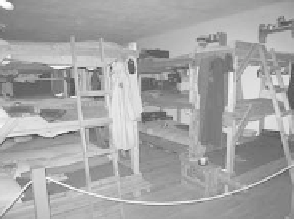Travel Reference
In-Depth Information
Germans out, were later used by Germans to keep the Jews in.
This was the Nazis' model “Jewish town,” a concentration
camp dolled up for propaganda
purposes. Here in this “self-
governed Jewish resettlement
area,” Jewish culture seemed to
thrive, as “citizens” put on plays
and concerts, published a maga-
zine, and raised their families.
But it was all a carefully planned
deception, intended to convince
Red Cross inspectors that the Jews
were being treated well. Virtually all of Terezín's Jews (155,000
over the course of the war) ultimately ended up dying either here
(35,000) or in extermination camps farther east.
One of the notable individuals held at Terezín was the
Viennese artist Friedl Dicker-Brandeis. This daring woman, a
leader in the Bauhaus art movement, found her life's calling in
teaching children freedom of expression. She taught the children in
the camp to distinguish between the central things—trees, flowers,
lines—and peripheral things, such as the conditions of the camp.
In 1944, Dicker-Brandeis volunteered to be sent to Auschwitz after
her husband was sent there; she was killed a month later.
Of the 15,000 children who passed through Terezín from
1942-1944, fewer than 100 survived. The artwork they created at
Terezín is a striking testimony to the cruel horror of the Holocaust.
In 1994, Hana Volavková, a Terezín survivor and the director of
the Jewish Museum in Prague, collected the children's artwork
and poems in the topic
I Never Saw Another Butterfly.
Selections
of the Terezín drawings are also displayed and well-described in
English in Prague's Pinkas Synagogue (see page 70). And in 2003,
a copy of 13-year-old Petr Ginz's drawing
Moon Country
was car-
ried into space by an Israeli astronaut (see sidebar).
Most well-known of the cultural activities that took place
at Terezín is the children's opera
Brundibár
. Written just before
the war, the anti-Fascist opera premiered secretly in Prague at a
time when Jewish activities
were no longer permit ted.
From 1943-1944 the play, per-
formed in Czech, ran 55 times
in the camp. After the war
it was staged internationally
(including a successful run on
Broadway) and was recently
rewritten in the US as a suc-
cessful children's book.






















